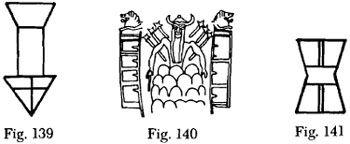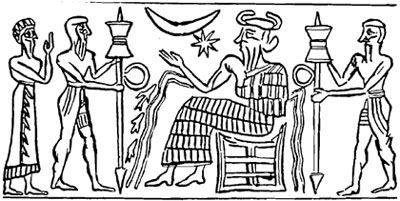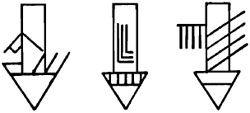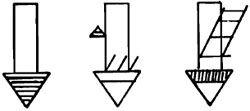The 12th Planet (50 page)
Authors: Zecharia Sitchin
Tags: #Non-Fiction, #Gnostic Dementia, #Fringe Science, #Retail, #Archaeology, #Ancient Aliens, #History

The Sumerian pictograph for AB.ZU was that of an excavation deep into Earth, mounted by a shaft. Thus, Ea was not the lord of an indefinite "watery deep," but the god in charge of the exploitation of Earth's minerals! (Fig. 139)


Fig. 142
In fact, the Greek
abyssos,
adopted from the Akkadian
apsu,
also meant an extremely deep hole in the ground. Akkadian textbooks explained that
"apsu
is
nikbu";
the meaning of the word and that of its Hebrew equivalent
nikba
is very precise: a deep, man-made cutting or drilling into the ground.
P. Jensen
(Die Kosmologie der Babylonier)
observed back in 1890 that the oft-encountered Akkadian term
Bit Nimiku
should not be translated as "house of wisdom" but as "house of deepness." He quoted a text (V.R30, 49–50ab) that stated: "It is from Bit Nimiku that gold and silver come." Another text (III.R57, 35ab), he pointed out, explained that the Akkadian name "Goddess Shala of
Nimiki"
was the translation of the Sumerian epithet "Goddess Who Hands the Shining Bronze." The Akkadian term
nimiku,
which has been translated as "wisdom," Jensen concluded, "had to do with metals." But why, he admitted simply, "I do not know."
Some Mesopotamian hymns to Ea exalt him as
Bel Nimiki,
translated "lord of wisdom"; but the correct translation should undoubtedly be "lord of mining." Just as the Tablet of Destinies at Nippur contained orbital data, it follows that the Tablet of Wisdom entrusted to Nergal and Ereshkigal was in fact a "Tablet of Mining," a "data bank" pertaining to the mining operations of the Nefilim.
As Lord of the Abzu, Ea was assisted by another son, the god GI.BlL ("he who burns the soil"), who was in charge of fire and smelting. Earth's Smith, he was usually depicted as a young god whose shoulders emit red-hot rays or sparks of fire, emerging from the ground or about to descend into it. The texts state that Gibil was steeped by Ea in "wisdom," meaning that Ea had taught him mining techniques. (Fig. 140)
The metal ores mined in southeastern Africa by the Nefilim were carried back to Mesopotamia by specially designed cargo ships called MA.GUR UR.NU AB.ZU ("ship for ores of the Lower World"). There, the ores were taken to Bad-Tibira, whose name literally meant "the foundation of metalworking." Smelted and refined, the ores were cast into ingots whose shape remained unchanged throughout the ancient world for millennia. Such ingots were actually found at various Near Eastern excavations, confirming the reliability of the Sumerian pictographs as true depictions of the objects they "wrote" out; the Sumerian sign for the term ZAG ("purified precious") was the picture of such an ingot. In earlier times it apparently had a hole running through its length, through which a carrying rod was inserted. (Fig. 141)
Several depictions of a God of the Flowing Waters show him flanked by bearers of such precious metal ingots, indicating that he was also the Lord of Mining. (Fig. 142)
The various names and epithets for Ea's African Land of Mines are replete with clues to its location and nature. It was known as A.RA.LI ("place of the shiny lodes"), the land from which the metal ores come. Inanna, planning her descent to the southern hemisphere, referred to the place as the land where "the precious metal is covered with soil"—where it is found underground. A text reported by Erica Reiner, listing the mountains and rivers of the Sumerian world, stated: "Mount Arali: home of the gold"; and a fragmented text described by H. Radau confirmed that Arali was the land on which Bad-Tibira depended for its continued operations.
The Mesopotamian texts spoke of the Land of Mines as mountainous, with grassy plateaus and steppes, and lush with vegetation. The capital of Ereshkigal in that land was described by the Sumerian texts as being in the GAB.KUR.RA ("in the chest of the mountains"), well inland. In the Akkadian version of Ishtar's journey, the gatekeeper welcomes her:
Enter my lady,
Let Kutu rejoice over thee;
Let the palace of the land of Nugia
Be glad at thy presence.
Conveying in Akkadian the meaning "that which is in the heartland," the term KU.TU in its Sumerian origin also meant "the bright uplands." It was a land, all texts suggest, with bright days, awash with sunshine. The Sumerian terms for gold (KU.GI—"bright out of earth") and silver (KU.BABBAR—"bright gold") retained the original association of the precious metals with the bright
(ku)
domain of Ereshkigal.
The pictographic signs employed as Sumer's first writing reveal great familiarity not only with diverse metallurgical processes but also with the fact that the sources of the metals were mines dug down into the earth. The terms for copper and bronze Chandsome-bright stone"), gold ("the supreme mined metal"), or "refined" ("bright-purified") were all pictorial variants of a mine shaft ("opening/mouth for dark-red" metal). (Fig. 143)
The land's name—Arali—could also be written as a variant of the pictograph for "dark-red" (soil), of
Kush
("dark-red," but in time meaning "Negro"), or of the metals mined there; the pictographs always depicted variants of a mine shaft. (Fig. 144)
Extensive references to gold and other metals in ancient texts suggest familiarity with metallurgy from the earliest times. A lively metals trade existed at the very beginnings of civilization, the result of knowledge bequeathed to Mankind by the gods, who, the texts state, had engaged in mining and metallurgy long before Man's appearance. Many studies that correlate Mesopotamian divine tales with the biblical pre-Diluvial list of patriarchs point out that, according to the Bible, Tubal-cain was an "artificer of gold and copper and iron" long before the Deluge.

Fig. 143

Fig. 144
The Old Testament recognized the land of Ophir, which was probably somewhere in Africa, as a source of gold in antiquity. King Solomon's ship convoys sailed down the Red Sea from Ezion-geber (present-day Elath). "And they went to Ophir and fetched from thence gold." Unwilling to risk a delay in the construction of the Lord's Temple in Jerusalem, Solomon arranged with his ally, Hiram, king of Tyre, to sail a second fleet to Ophir by an alternate route:
And the king had at sea a navy of Tarshish
with the navy of Hiram.
Once every three years came the navy of Tarshish,
bringing gold and silver, ivory and apes and monkeys.
The fleet of Tarshish took three years to complete a round trip. Allowing for an appropriate time to load up at Ophir, the voyage in each direction must have lasted well over a year. This suggests a route much more roundabout than the direct route via the Red Sea and the Indian Ocean—a route around Africa. (Fig. 145)

Fig. 145
Most scholars locate Tarshish in the western Mediterranean, possibly at or near the present Strait of Gibraltar. This would have been an ideal place from which to embark on a voyage around the African continent. Some believe that the name Tarshish meant "smeltery."
Many biblical scholars have suggested that Ophir should be identified with present-day Rhodesia. Z. Herman
(Peoples, Seas, Ships)
brought together evidence showing that the Egyptians obtained various minerals from Rhodesia in earliest times. Mining engineers in Rhodesia as well as in South Africa have often searched for gold by seeking evidence of prehistoric mining.
How was the inland abode of Ereshkigal reached? How were the ores transported from the "heartland" to the coastal ports? Knowing of the reliance of the Nefilim on river shipping, one should not be surprised to find a major, navigable river in the Lower World. The tale of "Enlil and Ninlil" informed us that Enlil was banished to exile in the Lower World. When he reached the land, he had to be ferried over a wide river.
A Babylonian text dealing with the origins and destiny of Mankind referred to the river of the Lower World as the River Habur, the "River of Fishes and Birds." Some Sumerian. texts nicknamed the Land of Ereshkigal the "Prairie Country of
H
A.BUR."
